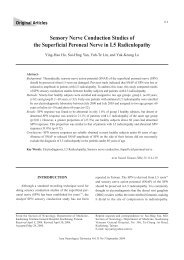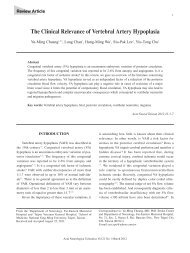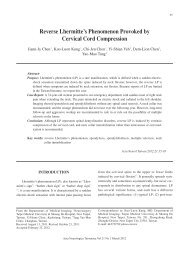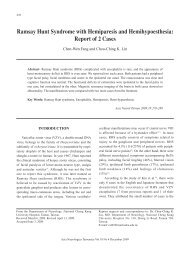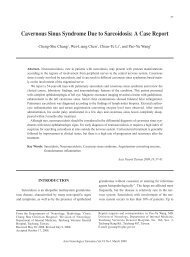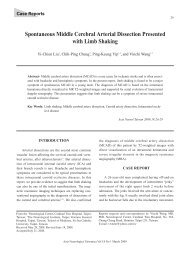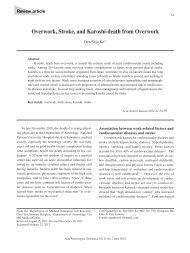Fatigue as the Only Clinical Manifestation of ... - ResearchGate
Fatigue as the Only Clinical Manifestation of ... - ResearchGate
Fatigue as the Only Clinical Manifestation of ... - ResearchGate
You also want an ePaper? Increase the reach of your titles
YUMPU automatically turns print PDFs into web optimized ePapers that Google loves.
184<br />
<strong>Fatigue</strong> <strong>as</strong> <strong>the</strong> <strong>Only</strong> <strong>Clinical</strong> <strong>Manifestation</strong> <strong>of</strong><br />
Colchicine Induced Myopathy<br />
Yang-Ching Lo 1,4 , Kong-Ping Lin 1,4 , Chia-Yi Lin 1,3,4 , Chuen-Der Kao 1,4,6 , Jen-Tse Chen 1,4,7 ,<br />
Kuan-Lin Lai 1,4,8 , Yung-Yang Lin 1,2,4,5 , Yi-Chung Lee 1,4 , Kwong-Kum Liao 1,4<br />
Abstract-<br />
Purpose: <strong>Fatigue</strong> may be induced by drug. Here, we reported that patients had fatigue after medication with<br />
colchicines.<br />
Method: Eight patients (8 Males, age: 42-72 years old) had fatigue but without weakness <strong>as</strong> <strong>the</strong>ir chief complaints.<br />
They all described an inability to maintain a sustained effort, which w<strong>as</strong> ameliorated by rest.<br />
Results: The course <strong>of</strong> fatigue w<strong>as</strong> insidious and progressive (mean 3.1 2.3 months, range 1-7 months)<br />
along with medication <strong>of</strong> colchicines (mean 20.3 5.5 months, range 11-28 months). <strong>Fatigue</strong> severity<br />
scale (patient: before drug withdrawal 5.41 0.19; 4 weeks after drug withdrawal 2.46 0.28; control<br />
2.12 0.45) showed fatigue <strong>as</strong> <strong>the</strong>ir most disabling symptom, sometimes preventing <strong>the</strong>m to carry<br />
on pr<strong>of</strong>essional <strong>as</strong> well <strong>as</strong> socio-familial activities. The pl<strong>as</strong>ma creatine kin<strong>as</strong>e elevated in <strong>the</strong>se 8<br />
patients before withdrawal <strong>of</strong> colchicines and returned to normal range in each subject 4 weeks after<br />
drug withdrawal. A probable diagnosis <strong>of</strong> drug-induced fatigue w<strong>as</strong> made when symptom subsided<br />
after colchicines were discontinued.<br />
Conclusion: It is emph<strong>as</strong>ized that side effect <strong>of</strong> drug should be considered <strong>as</strong> a differential diagnosis <strong>of</strong><br />
fatigue in patients having colchicines. Early recognition and diagnosis will prevent serious muscle damage.<br />
Key Words: colchicine, fatigue, myopathy.<br />
Acta Neurol Taiwan 2010;19:184-188<br />
INTRODUCTION<br />
<strong>Fatigue</strong> is not <strong>the</strong> same <strong>as</strong> weakness and is an independent<br />
symptom with an overwhelming sense <strong>of</strong> tiredness,<br />
lack <strong>of</strong> energy, and feeling <strong>of</strong> exhaustion. The definition<br />
<strong>of</strong> fatigue is exercise-induced reduction in <strong>the</strong><br />
maximal capacity to generate force or power output (1) or<br />
difficulty in initiation <strong>of</strong> or sustaining voluntary activi-<br />
From <strong>the</strong> Departments <strong>of</strong> 1 Neurology and 2 Medical Research,<br />
Taipei Veterans General Hospital, Taipei, Taiwan; 3 Department<br />
<strong>of</strong> Neurology, Chinese Medical University Hospital-Taipei<br />
Branch; Department <strong>of</strong> 4 Neurology and 5 Physiology, National<br />
Yang-Ming University, Taipei; 6 Department <strong>of</strong> Neurology,<br />
Taichung Hospital, Taiwan; 7 Department <strong>of</strong> Neurology, Cathay<br />
General Hospital, Taipei, Taiwan; 8 Department <strong>of</strong> Neurology,<br />
Taipei Municipal Gan-Dau Hospital, Taipei, Taiwan.<br />
Received February 24, 2010. Revised April 26, 2010.<br />
Accepted June 24, 2010.<br />
Correspondence to: Kwong-Kum Liao, MD. Department <strong>of</strong><br />
Neurology, Taipei Veterans General Hospital, No. 201, Sec. 2,<br />
Shih-Pai Road, Taipei 11217, Taiwan.<br />
E-mail: kkliao@vghtpe.gov.tw<br />
Acta Neurologica Taiwanica Vol 19 No 3 September 2010
185<br />
ties (2) , implying a decre<strong>as</strong>e in performance even in <strong>the</strong><br />
absence <strong>of</strong> permanent weakness. <strong>Fatigue</strong> mechanisms<br />
contain peripheral origin <strong>of</strong> muscle tissue and central<br />
origin <strong>of</strong> <strong>the</strong> nervous system, respectively (3-5) . The physiology<br />
<strong>of</strong> exercise-induced fatigue usually contains both<br />
components (4,5) .<br />
<strong>Fatigue</strong> is a common complaint in clinic and is<br />
reported <strong>as</strong> many <strong>as</strong> 20% <strong>of</strong> patients in primary care (2) .<br />
High prevalence <strong>of</strong> fatigue is noted in neurological dise<strong>as</strong>es<br />
such <strong>as</strong> stroke (6) , multiple sclerosis (7) , Parkinson’s<br />
dise<strong>as</strong>e (8) , chronic inflammatory demyelinating polyneuropathy<br />
(9) , my<strong>as</strong><strong>the</strong>nia gravis (10) , f<strong>as</strong>ioscapulohumeral<br />
dystrophy, myotonic dystrophy, and hereditary motor/<br />
sensory neuropathy type I (11) .<br />
Colchicines are usually prescribed for gout, Bechet’s<br />
dise<strong>as</strong>e, and familial Mediterranean fever, amyloidosis,<br />
and dermatoses (12) . In humans, colchicines myoneuropathy<br />
(CM) may occur insidiously after a long-term <strong>the</strong>rapy.<br />
Although both skeletal muscles and peripheral nerves<br />
are affected, myopathy is most prominent and <strong>as</strong>sociated<br />
axonal neuropathy is mild. Commonly, proximal weakness<br />
is <strong>the</strong> hallmark symptom when <strong>the</strong> diagnosis <strong>of</strong> CM<br />
is made. Several risk factors are noted in CM, such <strong>as</strong><br />
chronic renal failure, hepatic failure and drug interaction<br />
(13)<br />
. Most CM patients have good recovery after withdrawal<br />
<strong>of</strong> colchicines and related medication.<br />
<strong>Fatigue</strong> is usually underestimation and is generally<br />
investigated in <strong>the</strong> course or after recovery <strong>of</strong> <strong>the</strong> dise<strong>as</strong>e.<br />
However, it may be an early symptom <strong>of</strong> patients<br />
with neuromuscular disorder and precedes <strong>the</strong> onset <strong>of</strong><br />
weakness. Here, we report 8 CM patients with fatigue<br />
but without weakness <strong>as</strong> <strong>the</strong> chief complaint and emph<strong>as</strong>ize<br />
that drug-induced fatigue should be considered for<br />
primary care.<br />
METHODS<br />
Through referring system, we included 8 patients (8<br />
males, age range 42-72 years old) who fit <strong>the</strong> following<br />
criteria (Table 1): fatigue but without obvious weakness;<br />
history <strong>of</strong> medication with colchicines; myoneuropathy<br />
proved by electrophysiological studies; elevated creatine<br />
kin<strong>as</strong>e (CK); clinical improvement after drug withdrawal.<br />
None <strong>of</strong> our patients had corticosteroid or -blocker,<br />
but two patients had statin concomitantly. Statin w<strong>as</strong><br />
prescribed earlier than colchicines, 10 months for patient<br />
2 and 7 months for patient 7. Patient 8 had diabetes mellitus.<br />
None <strong>of</strong> our patients had thyroid dise<strong>as</strong>ed or<br />
depression. As CM features usually remitted within 4<br />
weeks after <strong>the</strong> drug w<strong>as</strong> discontinued (14) , <strong>the</strong> laboratory<br />
<strong>as</strong>sessments were followed up 4 weeks after diagnosis.<br />
<strong>Fatigue</strong> severity scale (FSS) w<strong>as</strong> applied to evaluate<br />
<strong>the</strong> impact <strong>of</strong> fatigue on subjects (14) . Essentially, <strong>the</strong> FSS<br />
is a short questionnaire that requires <strong>the</strong> subject to rate<br />
his or her own level <strong>of</strong> fatigue. To rate <strong>the</strong> severity <strong>of</strong><br />
fatigue symptoms, FSS questionnaire contains nine<br />
statements: 1. My motivation is lower when I am<br />
fatigued. 2. Exercise brings on my fatigue. 3. I am e<strong>as</strong>ily<br />
fatigued. 4. <strong>Fatigue</strong> interferes with my physical functioning.<br />
5. <strong>Fatigue</strong> causes frequent problems for me. 6. My<br />
fatigue prevents sustained physical functioning. 7.<br />
<strong>Fatigue</strong> interferes with carrying out certain duties and<br />
responsibilities. 8. <strong>Fatigue</strong> is among my three most disabling<br />
symptoms. 9. <strong>Fatigue</strong> interferes with my work,<br />
family, or social life. FSS w<strong>as</strong> <strong>as</strong>sessed in each patient<br />
before and 4 weeks after diagnosis. The subject w<strong>as</strong><br />
<strong>as</strong>ked to read each statement and circle a number from 1<br />
to 7, depending on how accurately it reflected his condition<br />
during <strong>the</strong> l<strong>as</strong>t week and <strong>the</strong> extent to which he<br />
agreed or disagreed that <strong>the</strong> statement applied to him. A<br />
low value (e.g., 1); indicated strong disagreement with<br />
<strong>the</strong> statement, where<strong>as</strong> a high value (e.g., 7); indicated<br />
strong agreement. The FSS w<strong>as</strong> calculated <strong>as</strong> <strong>the</strong> mean<br />
score <strong>of</strong> <strong>the</strong>se 9 items, with answers ranging from 1 (no<br />
signs <strong>of</strong> fatigue) to 7 (most disabling fatigue) (15) . Severe<br />
fatigue w<strong>as</strong> defined <strong>as</strong> a mean FSS-score <strong>of</strong> 5.0 or more<br />
(15)<br />
.<br />
Nerve conduction studies and electromyography<br />
were conducted in each patient. The muscle power w<strong>as</strong><br />
graded by Medical Research Council (MRC) score. A<br />
sum <strong>of</strong> MRC grades w<strong>as</strong> scored in <strong>the</strong> following muscle<br />
pairs: upper arm abductors, elbow flexors, wrist extensors,<br />
hip flexors, knee extensors, and dorsal foot flexors.<br />
The sum score <strong>of</strong> MRC ranges from 0 (paralysis) to 60<br />
(normal strength) (16) . Each patient had routine biochemistry<br />
including CK.<br />
Acta Neurologica Taiwanica Vol 19 No 3 September 2010
186<br />
Table 1. <strong>Clinical</strong> data <strong>of</strong> 8 patients <strong>of</strong> colchicines myopathy<br />
1 2 3 4 5 6 7 8<br />
Age 48 55 62 72 67 42 51 60<br />
Sex M M M M M M M M<br />
<strong>Fatigue</strong> duration (m) 4 7 2 1 1.5 6 1 2.5<br />
Muscle pain + - - - - + + -<br />
MRC sum score 60 60 60 60 60 60 60 60<br />
Numbness - - - + + - - +<br />
DTR N N D D D N N N<br />
Colchicines<br />
Dose (mg/d) 1.0 1.0 0.5 0.5 1.5 0.5 1.0 1.0<br />
Duration (m) 11 17 22 20 18 28 19 27<br />
Statins in use - + - - - - + -<br />
Renal insuff. - + - + - + + -<br />
Hepatic insuff. + - + - - - + +<br />
Creatine kin<strong>as</strong>e (U/L)<br />
Before withdrawal 253 335 766 468 225 664 534 242<br />
After withdrawal 126 168 106 68 70 38 90 154<br />
NCS/neuropathy - - - mild mild - - mild<br />
EMG/myopathy + + + + + + + +<br />
D: decre<strong>as</strong>ed; DTR: deep tendon reflex; Dx: diagnosis; EMG: electromyography; isuff.: insufficiency; N: normal ;NCS: nerve conduction<br />
study; M: months; MRC: Medical Research Council. Normal range <strong>of</strong> creatine kin<strong>as</strong>e: 22 to 198 U/L (units per liter)<br />
Table 2. <strong>Fatigue</strong> severity scale <strong>of</strong> patients with colchicines myopathy before and 4 weeks after colchicines withdrawal<br />
1 2 3 4 5 6 7 8<br />
before/after before/after before/after before/after before/after before/after before/after before/after<br />
1.My motivation is lower 5/2 4/2 5/3 6/4 5/3 4/2 4/2 5/3<br />
when I am fatigued.<br />
2.Exercise brings on my 5/2 5/2 6/3 6/4 6/3 4/2 5/2 5/3<br />
fatigue.<br />
3.I am e<strong>as</strong>ily fatigued. 6/3 6/3 5/3 5/3 5/3 6/3 5/3 5/3<br />
4.<strong>Fatigue</strong> interferes with 4/2 5/2 5/3 5/3 5/2 5/3 3/2 5/2<br />
my physical functioning.<br />
5.<strong>Fatigue</strong> causes frequent 4/2 5/2 4/2 4/2 5/2 4/2 3/2 5/3<br />
problems for me.<br />
6.My fatigue prevents 6/2 7/3 7/3 7/4 7/3 6/3 6/3 6/3<br />
sustained physical functioning.<br />
7.<strong>Fatigue</strong> interferes with 6/2 7/3 6/2 6/2 6/3 7/2 7/2 6/3<br />
carrying out certain<br />
duties and responsibilities.<br />
8.<strong>Fatigue</strong> is among my 6/2 5/2 6/2 6/2 6/2 7/2 7/2 7/2<br />
three most disabling symptoms.<br />
9.<strong>Fatigue</strong> interferes with 5/2 5/2 5/2 5/2 5/2 6/2 6/2 6/2<br />
my work, family, or social life.<br />
Average 5.2/2.1 5.4/2.3 5.4/2.6 5.6/2.9 5.6/2.6 5.4/2.3 5.1/2.2 5.6/2.7<br />
Acta Neurologica Taiwanica Vol 19 No 3 September 2010
187<br />
The Wilcoxon rank sum test w<strong>as</strong> applied to find a<br />
significant difference in <strong>the</strong> change <strong>of</strong> patient’s data. A<br />
change w<strong>as</strong> considered significant if p < 0.05.<br />
RESULTS<br />
The main clinical findings were summarized in<br />
Table 1. The course <strong>of</strong> fatigue w<strong>as</strong> 3.1 2.3 months<br />
(range 1-7 months) with medication <strong>of</strong> colchicines about<br />
20.3 5.5 months (range 11-28 months). Weakness w<strong>as</strong><br />
defined muscle power less than 5 (i.e. MRC grade equal<br />
or less than 4). The MRC sum score <strong>of</strong> each patient w<strong>as</strong><br />
60 before and after drug withdrawal. Electrophysiological<br />
results were consistent with myopathy in 8 patients<br />
and mild axonal neuropathy in 3. These electromyographic<br />
findings rapidly resolved within 4 weeks <strong>of</strong> drug<br />
discontinuation.<br />
All our patients had normal thyroid function. Pl<strong>as</strong>ma<br />
CK values returned to <strong>the</strong> normal level for each patient 4<br />
weeks after colchicines withdrawal (before withdrawal<br />
435.9 206.1 U/L; after withdrawal 102.5 44.8 U/L;<br />
p = 0.0009) (Table 1). Severe fatigue (FSS > 5) w<strong>as</strong><br />
noted in each patient (Table 2). Most <strong>of</strong> <strong>the</strong> patients<br />
described an inability to maintain a sustained effort,<br />
which w<strong>as</strong> ameliorated by rest. All <strong>the</strong> patients described<br />
fatigue <strong>as</strong> <strong>the</strong>ir most disabling symptom, sometimes preventing<br />
<strong>the</strong>m to carry on pr<strong>of</strong>essional <strong>as</strong> well <strong>as</strong> soci<strong>of</strong>amilial<br />
activities. After drug withdrawal, <strong>the</strong>y all had a<br />
rapid recovery with FSS from 5.41 0.19 to 2.46 <br />
0.28 (p = 0.0009). FSS w<strong>as</strong> higher in CM patients than<br />
controls (2.12 0.45) before drug withdrawal (p =<br />
0.0004).<br />
DISCUSSION<br />
The onset <strong>of</strong> fatigue <strong>of</strong> our patients occurred 11-28<br />
months after exposure to <strong>the</strong>rapeutic dose <strong>of</strong> colchicines.<br />
It seemed that CM developed insidiously in our patients.<br />
The diagnosis <strong>of</strong> CM w<strong>as</strong> made 1-7 months after <strong>the</strong><br />
onset <strong>of</strong> fatigue. It w<strong>as</strong> difficult for physicians to make<br />
<strong>the</strong> early diagnosis with a nonspecific complaint <strong>of</strong><br />
fatigue only. CK is a sensitive indicator for <strong>the</strong> diagnosis<br />
<strong>of</strong> myopathy, but it is lack <strong>of</strong> specificity. In a literature<br />
review, <strong>the</strong> pl<strong>as</strong>ma CK level might incre<strong>as</strong>e up to 31110<br />
U/L in CM patients, but not all <strong>the</strong> CM patients had elevated<br />
CK values (17) . CM patients might complain <strong>of</strong><br />
numbness only without myalgia or weakness (18) . In <strong>the</strong><br />
series <strong>of</strong> Wallace SL et al. (19) , one <strong>of</strong> <strong>the</strong>ir CM patients<br />
w<strong>as</strong> noted to have elevated CK value but without any<br />
symptoms. Therefore, elevated CK value is not <strong>the</strong> diagnostic<br />
criteria <strong>of</strong> drug-induced myopathy and not all<br />
patients with elevated CK value complain <strong>of</strong> fatigue or<br />
weakness.<br />
The pathogenesis <strong>of</strong> CM is related to a direct toxic<br />
effect on muscle cells (20) . Although dosing effect w<strong>as</strong> not<br />
clear in our patients, 4 <strong>of</strong> our patients had renal insufficiency,<br />
and 4 had hepatic dysfunction. Colchicines are<br />
eliminated predominantly by secretion into bile and partly<br />
by renal secretion. Impairment at ei<strong>the</strong>r site will<br />
incre<strong>as</strong>e <strong>the</strong> serum concentration <strong>of</strong> colchicines (19) .<br />
Therefore, dose adjustments <strong>of</strong> colchicines are necessary<br />
for patients with underlying renal or hepatic dysfunction.<br />
It is obvious that o<strong>the</strong>r causes should be considered in<br />
our patients in <strong>the</strong> differential diagnosis <strong>of</strong> fatigue. As<br />
neuropathy w<strong>as</strong> noted in only 3 subjects, neuropathy<br />
should not account for <strong>the</strong> fatigue for all <strong>the</strong> subjects.<br />
Two <strong>of</strong> our patients (patients 2 and 6) had had fatigue<br />
more than 6 months. Chronic fatigue syndrome h<strong>as</strong> been<br />
considered for <strong>the</strong>m two in <strong>the</strong> differential diagnosis.<br />
However, fatigue could be alleviated by rest in our<br />
patients but not in chronic fatigue syndrome (21) .<br />
Therefore, chronic fatigue syndrome w<strong>as</strong> clearly not <strong>the</strong><br />
diagnosis <strong>of</strong> <strong>the</strong>m two. We could not completely exclude<br />
<strong>the</strong> possibilities <strong>of</strong> anxiety, depression or sleep disturbance<br />
which might also have a role in <strong>the</strong> symptom <strong>of</strong><br />
fatigue. However, resolution <strong>of</strong> <strong>the</strong> fatigue after<br />
colchicines discontinuation strongly supports <strong>the</strong> diagnosis<br />
<strong>of</strong> CM. <strong>Fatigue</strong> h<strong>as</strong> been recognized <strong>as</strong> a frequent<br />
feature <strong>of</strong> <strong>the</strong> neurological dise<strong>as</strong>es and does not correlate<br />
with <strong>the</strong> level <strong>of</strong> weakness or sensory disturbance (15) .<br />
Our report fur<strong>the</strong>r indicates that fatigue may precede<br />
weakness and present <strong>as</strong> <strong>the</strong> initial manifestation <strong>of</strong><br />
drug-induced myopathy. Drug-induced myopathy should<br />
be considered in <strong>the</strong> differential diagnosis <strong>of</strong> progressive,<br />
disabling fatigue in patients receiving colchicines.<br />
Early recognition and drug cessation may shorten <strong>the</strong><br />
Acta Neurologica Taiwanica Vol 19 No 3 September 2010
188<br />
length and severity <strong>of</strong> morbidity.<br />
ACKNOWLEDGEMENT<br />
The study w<strong>as</strong> supported by a grant from Taipei<br />
Veterans General Hospital (V96C1-044).<br />
REFERENCES<br />
1. Vøllestad NK. Me<strong>as</strong>urement <strong>of</strong> human muscle fatigue. J<br />
Neurosci Methods 1997;74:219-227.<br />
2. Chaudhuri A, Behan PO. <strong>Fatigue</strong> in neurological disorders.<br />
Lancet 2004;363:978-988.<br />
3. Gandevia SC. Spinal and supr<strong>as</strong>pinal factors in human<br />
muscle fatigue. Physiol Rev 2001;81:1725-1789.<br />
4. Kent-Braun JA. Central and peripheral contributions to<br />
muscle fatigue in humans during sustained maximal effort.<br />
Eur J Appl Physiol Occup Physiol 1999;80:57-63.<br />
5. Schillings ML, Hoefsloot W, Stegeman DF, Zwarts MJ.<br />
Relative contributions <strong>of</strong> central and peripheral factors to<br />
fatigue during a maximal sustained effort. Eur J Appl<br />
Physiol 2003;90:562-568.<br />
6. Staub F, Bogousslavsky J. <strong>Fatigue</strong> after stroke: a major but<br />
neglected issue. Cerebrov<strong>as</strong>c Dis 2001;12:75-81.<br />
7. Krupp LB. <strong>Fatigue</strong> in multiple sclerosis: definition, pathophysiology<br />
and treatment. CNS Drugs 2003;17:225-234.<br />
8. Havlikova E, Rosenberger J, Nagyova I, Middel B,<br />
Dubayova T, Gdovinova Z, van Dijk JP, Grooth<strong>of</strong>f JW.<br />
Impact <strong>of</strong> fatigue on quality <strong>of</strong> life in patients with<br />
Parkinson’s dise<strong>as</strong>e. Eur J Neurol 2008;15:475-480.<br />
9. Boukhris S, Magy L, Gallouedec G, Khalil M, Couratier P,<br />
Gil J, Vallat JM. <strong>Fatigue</strong> <strong>as</strong> <strong>the</strong> main presenting symptom<br />
<strong>of</strong> chronic inflammatory demyelinating polyradiculoneuropathy:<br />
a study <strong>of</strong> 11 c<strong>as</strong>es. J Peripher Nerv Syst 2005;10:<br />
329-337.<br />
10. Kittiwatanapaisan W, Gauthier DK, Williams AM, Oh SJ.<br />
<strong>Fatigue</strong> in My<strong>as</strong><strong>the</strong>nia Gravis patients. J Neurosci Nurs<br />
2003;35:87-93.<br />
11. Kalkman JS, Schillings ML, van der Werf SP, Padberg GW,<br />
Zwarts MJ, van Engelen BG, Bleijenberg G. Experienced<br />
fatigue in facioscapulohumeral dystrophy, myotonic dystrophy,<br />
and HMSN-I. J Neurol Neurosurg Psychiatry 2005;76:<br />
1406-1409.<br />
12. Zuckner J. Drug-related myopathies. Rheum Dis Clin<br />
North Am 1994;20:1017-1032.<br />
13. Owczarek J, J<strong>as</strong>ińska M, Orszulak-Michalak D. Druginduced<br />
myopathies. An overview <strong>of</strong> <strong>the</strong> possible mechanisms.<br />
Pharmacol Rep 2005;57:23-34<br />
14. Kuncl RW, Cornblath DR, Avila O, Duncan G.<br />
Electrodiagnosis <strong>of</strong> human colchicines myoneuropathy.<br />
Muscle Nerve 1989;12:360-364.<br />
15. Merkies IS, Schmitz PI, Samijn JP, van der Meché FG, van<br />
Doorn PA. <strong>Fatigue</strong> in immune-mediated polyneuropathies.<br />
European Inflammatory Neuropathy Cause and Treatment<br />
(INCAT) Group. Neurology 1999;53:1648-1654.<br />
16. Merkies IS, Schmitz PI, Van Der Meché FG, Van Doorn<br />
PA. Comparison between impairment and disability scales<br />
in immune-mediated polyneuropathies. Muscle Nerve<br />
2003;28:93-100.<br />
17. Wilbur K, Makowsky M. Colchicine myotoxicity: c<strong>as</strong>e<br />
reports and literature review. Pharmaco<strong>the</strong>rapy 2004;24:<br />
1784-1792.<br />
18. Montseny JJ, Meyrier A, Gherardi RK. Colchicine toxicity<br />
in patients with chronic renal failure. Nephrol Dial<br />
Transplant 1996;11:2055-2058.<br />
19. Wallace SL, Singer JZ, Duncan GJ, Wigley FM, Kuncl RW.<br />
Renal function predicts colchicine toxicity: guidelines for<br />
<strong>the</strong> prophylactic use <strong>of</strong> colchicine in gout.J Rheumatol<br />
1991;18:264-269.<br />
20. Kuncl RW, Bilak MM, Craig SW, Adams R. Exocytotic<br />
“constipation” is a mechanism <strong>of</strong> tubulin/lysosomal interaction<br />
in colchicines myopathy. Exp Cell Res 2003;285:196-<br />
207.<br />
21. Fukuda K, Straus SE, Hickie I, Sharpe MC, Dobbins JG,<br />
Komar<strong>of</strong>f A. The chronic fatigue syndrome: a comprehensive<br />
approach to its definition and study. International<br />
Chronic <strong>Fatigue</strong> Syndrome Study Group. Ann Intern Med<br />
1994;121:953-959.<br />
Acta Neurologica Taiwanica Vol 19 No 3 September 2010



